For me, Washington D.C. is all about the buildings. In my world of keywording, buildings also include monuments, bridges, and memorials. Steeped in history, full of stories, iconic, architecture, and design all catch my eye. I couldn’t get enough. Here they are, in no particular order.
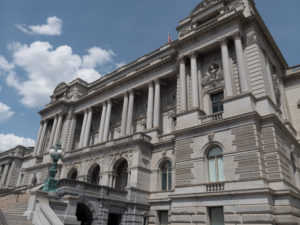 The Library of Congress was NOT what I pictured it to be. From what we saw it was much more a museum than a library. Apparently, it is the official research library that serves the United States Congress and is the de facto national library of the United States. It is the oldest federal cultural institution in the country and is one of the largest libraries in the world. Its collections are universal, not limited by subject, format, or national boundary, and include research materials from all parts of the world and in more than 470 languages. Who knew?
The Library of Congress was NOT what I pictured it to be. From what we saw it was much more a museum than a library. Apparently, it is the official research library that serves the United States Congress and is the de facto national library of the United States. It is the oldest federal cultural institution in the country and is one of the largest libraries in the world. Its collections are universal, not limited by subject, format, or national boundary, and include research materials from all parts of the world and in more than 470 languages. Who knew?
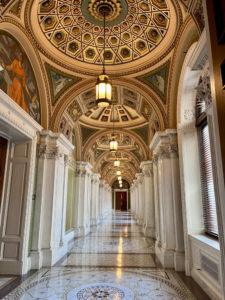
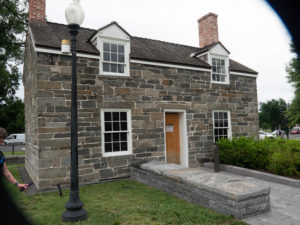 We stumbled across this building on our way to a March for our Lives rally. Excluding the White House, the Lockkeeper’s House is the oldest building on the National Mall, built in 1837.
We stumbled across this building on our way to a March for our Lives rally. Excluding the White House, the Lockkeeper’s House is the oldest building on the National Mall, built in 1837.
The building dates to a period when this area was a wharf and was the location of a section of the Washington City Canal, which connected the Potomac and Anacostia rivers. Here, an eastward extension of the Chesapeake and Ohio Canal met the Potomac River and the Washington City Canal at a canal lock.
The 350-square-foot house served the canal lock keeper, who collected tolls, recorded commerce, maintained the canal, and managed traffic.
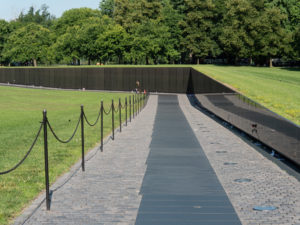 The Vietnam Memorial was powerful. The names on the Wall, originally numbering 57,939 when it was dedicated in 1982, are listed in the chronological order of the casualty dates. It’s interesting how short the wall is from the early days of the war and startling how tall it gets in the middle. Additional names have since been added and as of May 2018, there were 58,320 names. The number of names on the wall is different from the official number of U.S. Vietnam War deaths, which is 58,220 as of May 2018.
The Vietnam Memorial was powerful. The names on the Wall, originally numbering 57,939 when it was dedicated in 1982, are listed in the chronological order of the casualty dates. It’s interesting how short the wall is from the early days of the war and startling how tall it gets in the middle. Additional names have since been added and as of May 2018, there were 58,320 names. The number of names on the wall is different from the official number of U.S. Vietnam War deaths, which is 58,220 as of May 2018.
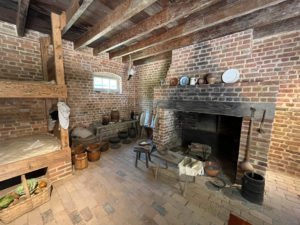
Mount Vernon was a beautiful way to spend an afternoon. The main building was under renovation so we wandered the grounds. It became less beautiful as we entered the slave quarters and realized how many people were owned to make these grounds a working farm back in the day. The above image is a room of the restored slave quarters.
The plantation is on the banks of the Potomac River in Fairfax County, Virginia, just south of Washington, D.C.
The Washington family acquired land in the area in 1674. Around 1734, the family embarked on an expansion of its estate that continued under George Washington, who began leasing the estate in 1754 before becoming its sole owner in 1761.
In 1858, the house’s historical importance was recognized and it was saved from ruin by the Mount Vernon Ladies Association; this philanthropic organization acquired it together with part of the Washington property estate. Escaping the damage suffered by many plantation houses during the American Civil War, Mount Vernon was restored.
Mount Vernon was designated a National Historic Landmark in 1960 and is listed on the National Register of Historic Places. It is still owned and maintained in trust by the Mount Vernon Ladies Association and is open every day of the year. Allowing the public to see the estate is not an innovation, but part of an over 200-year-old tradition started by George Washington himself. In 1794 he wrote: “I have no objection to any sober or orderly person’s gratifying their curiosity in viewing the buildings, Gardens, &ca. about Mount Vernon.”
This is an image of the lower floor of a round barn found on the property. It was invented to have hay laid out on the above floor, have horses walk on it, and ground it up to have it fall through to the bottom floor and be swept up and used. It was cutting-edge technology back then.
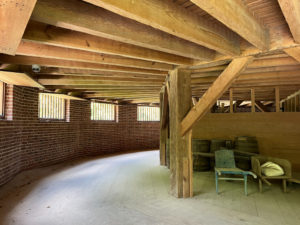
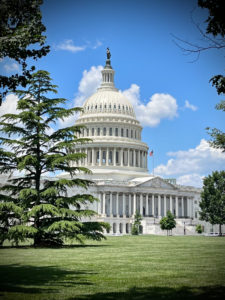 The Capital is located on Capitol Hill at the eastern end of the National Mall. Though no longer at the geographic center of the federal district, the Capitol forms the origin point for the district’s street-numbering system and the district’s four quadrants.
The Capital is located on Capitol Hill at the eastern end of the National Mall. Though no longer at the geographic center of the federal district, the Capitol forms the origin point for the district’s street-numbering system and the district’s four quadrants.
Central sections of the present building were completed in 1800. These were partly destroyed in the 1814 burning of Washington, then were fully restored within five years. The building was later enlarged by extending the wings for the chambers for the bicameral legislature, the House of Representatives in the south wing, and the Senate in the north wing. The massive dome was completed around 1866 just after the American Civil War.
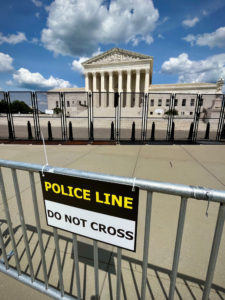 The Supreme Court Building also referred to as “The Marble Palace,” serves as the official workplace of the Chief Justice of the United States and the eight Associate Justices of the Supreme Court. It is located in the block immediately east of the United States Capitol and north of the Library of Congress. On May 4, 1987, the Supreme Court Building was designated a National Historic Landmark.
The Supreme Court Building also referred to as “The Marble Palace,” serves as the official workplace of the Chief Justice of the United States and the eight Associate Justices of the Supreme Court. It is located in the block immediately east of the United States Capitol and north of the Library of Congress. On May 4, 1987, the Supreme Court Building was designated a National Historic Landmark.
The proposal for a separate building for the Supreme Court was suggested in 1912 by President William Howard Taft, who became Chief Justice in 1921. In 1929, Taft successfully argued for the creation of the new building but did not live to see it built. Physical construction began in 1932 and was officially completed in 1935 under the guidance of Chief Justice Charles Evans Hughes, Taft’s successor.
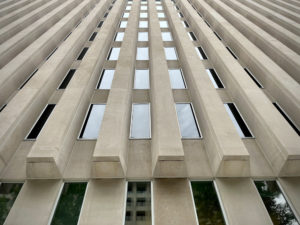 I don’t remember what this building is but we got out of the car, I looked up and saw this…so I SHOT it.
I don’t remember what this building is but we got out of the car, I looked up and saw this…so I SHOT it.
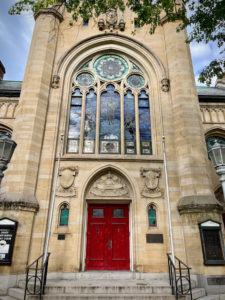
Beautiful architecture was everywhere, be it churches, office buildings, or homes, it was everywhere.
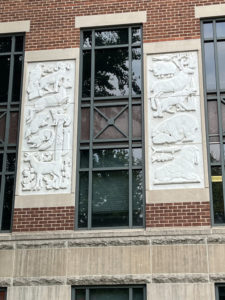
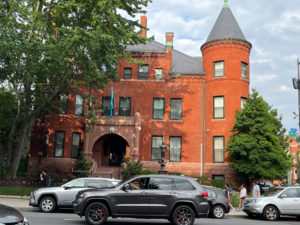 Walking from one place to another, outside of the National Mall, we would come across random buildings like the Embassy of Kazakstan.
Walking from one place to another, outside of the National Mall, we would come across random buildings like the Embassy of Kazakstan.
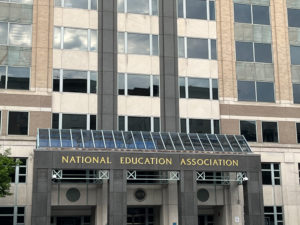 The National Education Association.
The National Education Association.
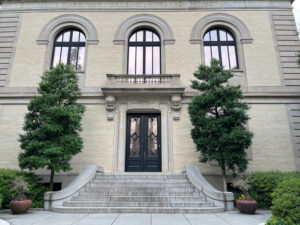 The National Geographic Society.
The National Geographic Society.
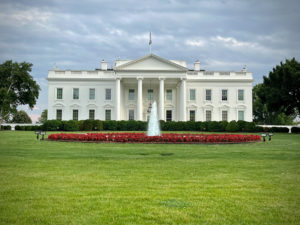 An iPhone picture of the White House. Some days you could get right up to the gate and some days not. Today was a good day.
An iPhone picture of the White House. Some days you could get right up to the gate and some days not. Today was a good day.
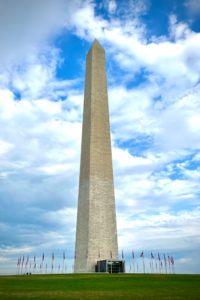 The Washington Monument’s construction began in 1848 and was halted for a period of 23 years, from 1854 to 1877 due to a lack of funds, a struggle for control over the Washington National Monument Society, and the American Civil War. It was built to commemorate George Washington, once commander-in-chief of the Continental Army (1775–1784) in the American Revolutionary War and the first President of the United States (1789–1797). Located almost due east of the Reflecting Pool and the Lincoln Memorial, the monument, made of marble, granite, and bluestone gneiss, is both the world’s tallest predominantly stone structure and the world’s tallest obelisk at 555 feet 5+1⁄8 inches (169.294 m) tall, according to the National Park Service (measured 1884). It is the tallest monumental column in the world if all are measured above their pedestrian entrances. The cornerstone was laid on July 4, 1848; the first stone was laid atop the unfinished stump on August 7, 1880; the capstone was set on December 6, 1884; the completed monument was dedicated on February 21, 1885; and officially opened October 9, 1888.
The Washington Monument’s construction began in 1848 and was halted for a period of 23 years, from 1854 to 1877 due to a lack of funds, a struggle for control over the Washington National Monument Society, and the American Civil War. It was built to commemorate George Washington, once commander-in-chief of the Continental Army (1775–1784) in the American Revolutionary War and the first President of the United States (1789–1797). Located almost due east of the Reflecting Pool and the Lincoln Memorial, the monument, made of marble, granite, and bluestone gneiss, is both the world’s tallest predominantly stone structure and the world’s tallest obelisk at 555 feet 5+1⁄8 inches (169.294 m) tall, according to the National Park Service (measured 1884). It is the tallest monumental column in the world if all are measured above their pedestrian entrances. The cornerstone was laid on July 4, 1848; the first stone was laid atop the unfinished stump on August 7, 1880; the capstone was set on December 6, 1884; the completed monument was dedicated on February 21, 1885; and officially opened October 9, 1888.
We never did secure tickets to go up in it. Next time.
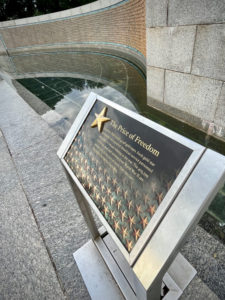 The World War II Memorial was stunning. But this plaque was possibly the most important part of the memorial. It is the Freedom Wall. It explains the price of freedom in very real terms. The wall holds 4,048 gold stars you can see behind the sign to the left. Each star represents one hundred American service personnel who died or remain missing in the war. The 405,399 Americans dead and missing from World War II are second only to the loss of more than 620,000 Americans during our Civil War. And THAT only includes our country. And only service members. Let that sink in for a minute.
The World War II Memorial was stunning. But this plaque was possibly the most important part of the memorial. It is the Freedom Wall. It explains the price of freedom in very real terms. The wall holds 4,048 gold stars you can see behind the sign to the left. Each star represents one hundred American service personnel who died or remain missing in the war. The 405,399 Americans dead and missing from World War II are second only to the loss of more than 620,000 Americans during our Civil War. And THAT only includes our country. And only service members. Let that sink in for a minute.
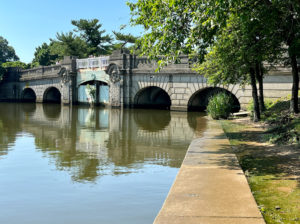
This is a super cute little bridge along the waterway of the Jefferson Memorial whose pillars you can see below.
I found this quote on the Southeast wall to be very pertinent to today’s politics: “I am not an advocate for frequent changes in laws and constitutions, but laws and institutions must go hand in hand with the progress of the human mind. As that becomes more developed, more enlightened, as new discoveries are made, new truths discovered and manners and opinions change, with the change of circumstances, institutions must advance also to keep pace with the times. We might as well require a man to wear still the coat which fitted him when a boy as civilized society to remain ever under the regimen of their barbarous ancestors.” I have more to say but I’ll stop there. 😉
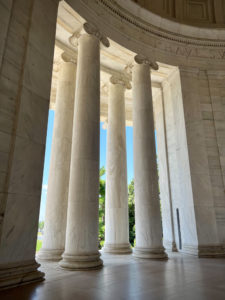
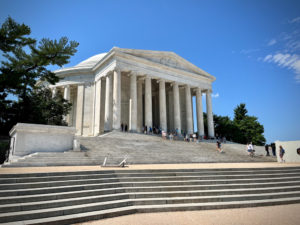
The Lincoln Memorial was dedicated in May 1922. It has always been a major tourist attraction and since the 1930s has sometimes been a symbolic center focused on race relations.
The memorial has been the site of many famous speeches, including Martin Luther King Jr.’s “I Have a Dream” speech delivered on August 28, 1963, during the rally at the end of the March on Washington for Jobs and Freedom.
The memorial is open to the public 24 hours a day, and more than 7 million people visit it annually.
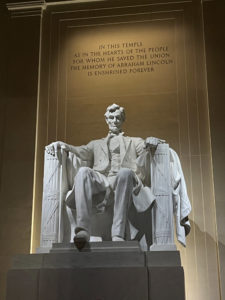
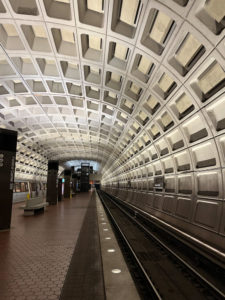 Even the Metro station is kinda cool inside.
Even the Metro station is kinda cool inside.
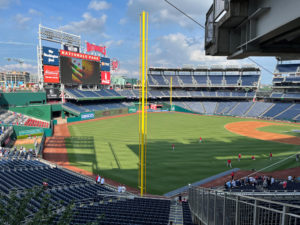 We went to a Washington Nationals Major League Baseball game with our friends. I even ate a hot dog.
We went to a Washington Nationals Major League Baseball game with our friends. I even ate a hot dog.
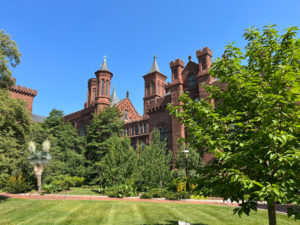 The Smithsonian Institution is legendary. I learned this at an exhibit: “The Smithsonian Institution started with a gift from an 18th-century English scientist named James Smithson who left his fortune to the United States, a country he had never seen. This exhibition looks at the history of the Smithsonian, focusing on its research, museums, and public programs in art, culture, history, and science and the role of the American public in the Smithsonian museums and research.
The Smithsonian Institution is legendary. I learned this at an exhibit: “The Smithsonian Institution started with a gift from an 18th-century English scientist named James Smithson who left his fortune to the United States, a country he had never seen. This exhibition looks at the history of the Smithsonian, focusing on its research, museums, and public programs in art, culture, history, and science and the role of the American public in the Smithsonian museums and research.
The Smithsonian is a partnership between its specialist staff and the American people. ”
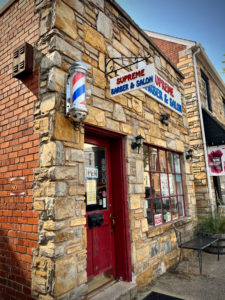
Walking around old Alexandria we ran into some old buildings.
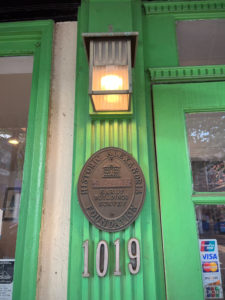
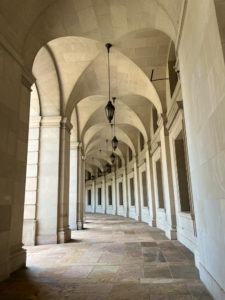 I’m not sure what this building is but we emerged from the underground Metro to this. Stunning.
I’m not sure what this building is but we emerged from the underground Metro to this. Stunning.
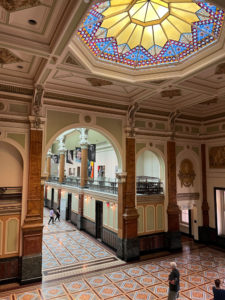 This is the National Portrait Gallery which is full of, you guessed it, portraits! Among other art pieces.
This is the National Portrait Gallery which is full of, you guessed it, portraits! Among other art pieces.
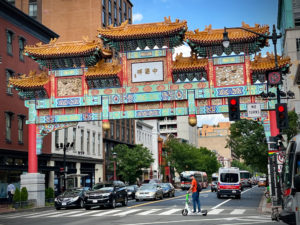 We didn’t go into Chinatown but found one of the entrances to it near the portrait gallery. Again, next time.
We didn’t go into Chinatown but found one of the entrances to it near the portrait gallery. Again, next time.
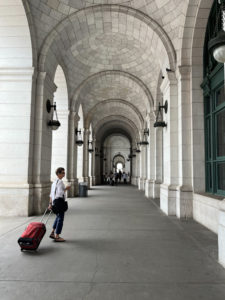 Here’s Ellen at Union Station, on our way to find the Amtrak train that will take us to New York City.
Here’s Ellen at Union Station, on our way to find the Amtrak train that will take us to New York City.
I hope you enjoyed the small sampling of the buildings we encountered on the D.C. portion of our June adventure.
Until next week, Happy Shooting!!
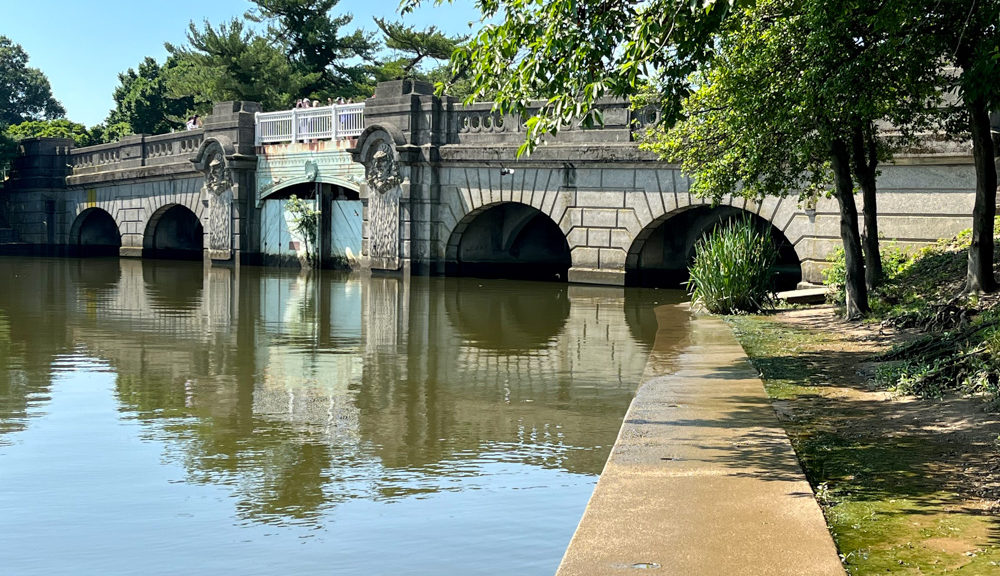





























 Walking by the Navy vessels on our way to dinner one night I captured this guy fishing at the base of an aircraft carrier.
Walking by the Navy vessels on our way to dinner one night I captured this guy fishing at the base of an aircraft carrier. Patterns in nature…
Patterns in nature… A more than life-sized statue kissing his girl after returning home from WWII.
A more than life-sized statue kissing his girl after returning home from WWII.


 Finding a random California Poppy among all of this cement was pretty cool
Finding a random California Poppy among all of this cement was pretty cool



 Such an interesting combination of sign and statue. Like…are you welcoming me to…the end? Yikes!
Such an interesting combination of sign and statue. Like…are you welcoming me to…the end? Yikes!

 Here are some plants and a pet that requires little attention.
Here are some plants and a pet that requires little attention.













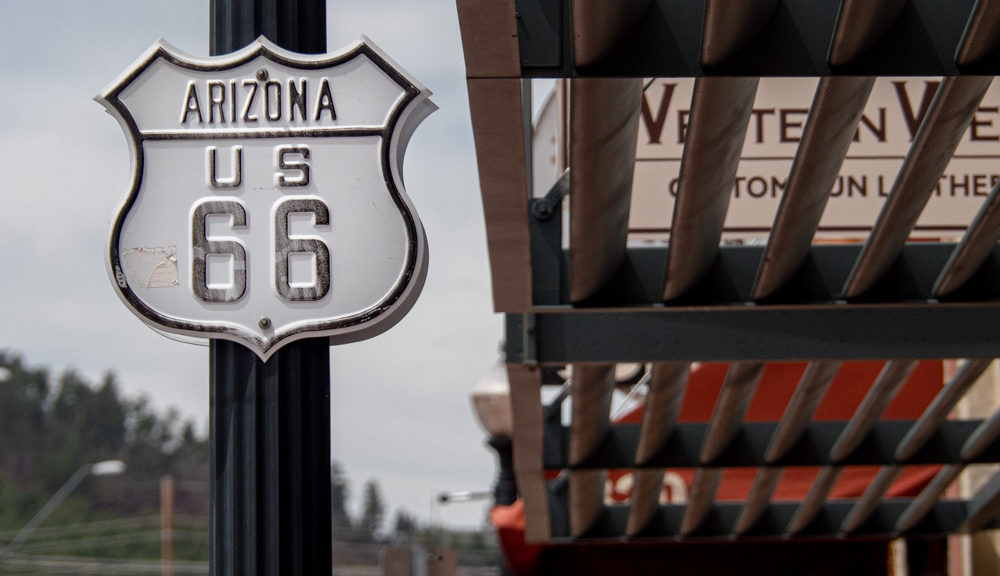
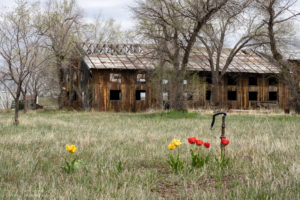
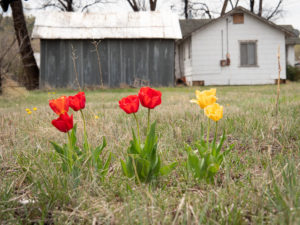
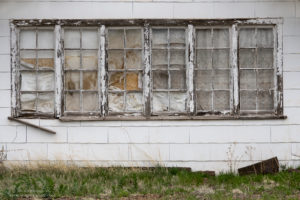
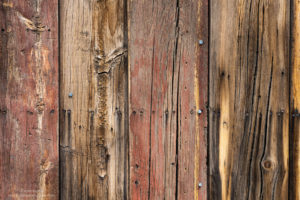
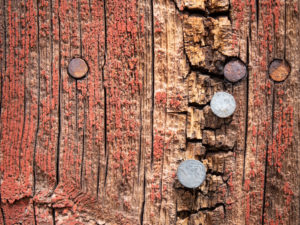
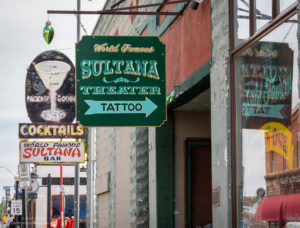
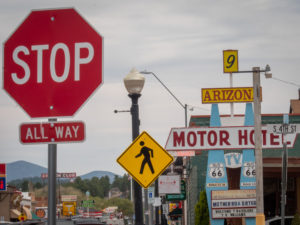
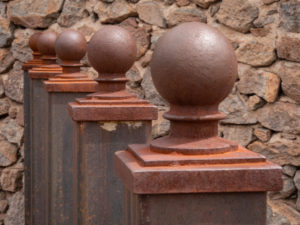
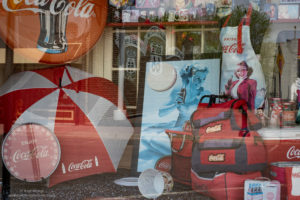
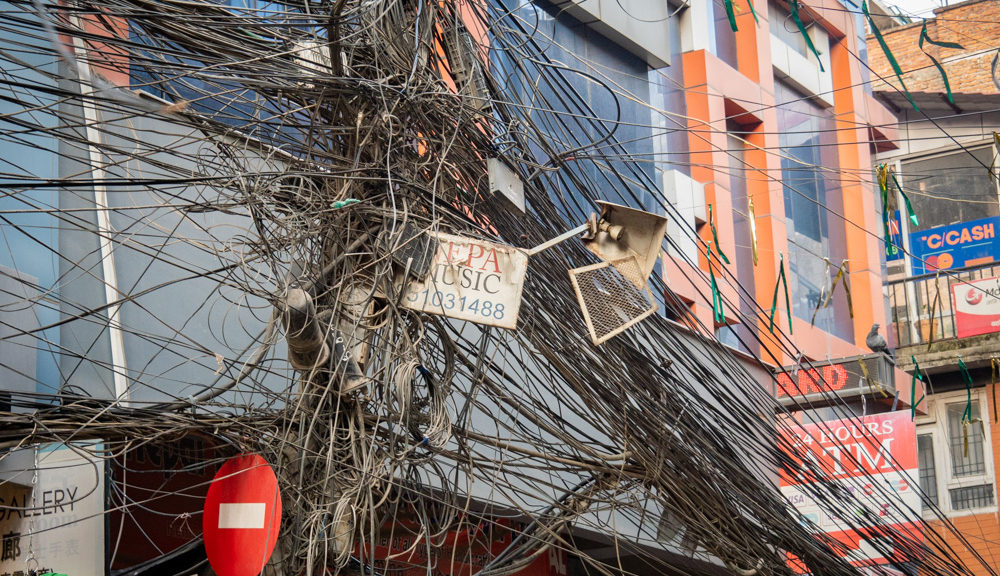
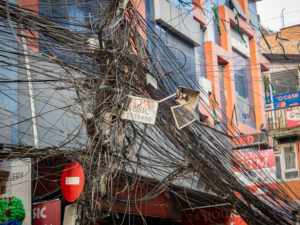
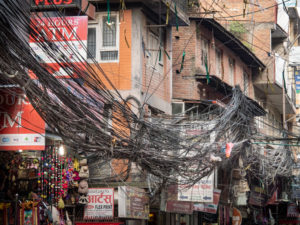
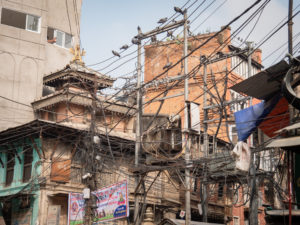

 This is a section of a structure at the mining park at the entrance to the Jerome State Park in the hills above Cottonwood, AZ. I like how it turned out as a black and white and how the wood beams radiate out from the main beam at the center.
This is a section of a structure at the mining park at the entrance to the Jerome State Park in the hills above Cottonwood, AZ. I like how it turned out as a black and white and how the wood beams radiate out from the main beam at the center. This wall was nicely lit at the state park. Brick adds such character.
This wall was nicely lit at the state park. Brick adds such character. Rusted old signs always intrigue me. I try to imagine what purpose they had for the people they were build for and how they fit into their lives.
Rusted old signs always intrigue me. I try to imagine what purpose they had for the people they were build for and how they fit into their lives. The Hotel Connor, home to the Spirit Room, is a local bar that hosts live music and is a popular motorcycle destination.
The Hotel Connor, home to the Spirit Room, is a local bar that hosts live music and is a popular motorcycle destination. This Mexican food restaurant was closed but I loved the chair backs. I shot this image through the front window.
This Mexican food restaurant was closed but I loved the chair backs. I shot this image through the front window. The winding roads and switchbacks that make up the streets of Jerome have a lot of signs to help with the flow of traffic. You can get from Cottonwood to Prescott via this great little artisan community.
The winding roads and switchbacks that make up the streets of Jerome have a lot of signs to help with the flow of traffic. You can get from Cottonwood to Prescott via this great little artisan community. Speaking of artists, this is the front door of Katie Lee, a long time environmentalist and champion of Glenn Canyon that was swallowed up by Lake Powell when the Glenn Canyon Dam was build in the 1960’s. She passed away in November at the ripe old age of 98. Rest in peace Katie.
Speaking of artists, this is the front door of Katie Lee, a long time environmentalist and champion of Glenn Canyon that was swallowed up by Lake Powell when the Glenn Canyon Dam was build in the 1960’s. She passed away in November at the ripe old age of 98. Rest in peace Katie. This red rocker is on the porch of the Surgeon’s House which was built for the local doctor once upon a time. It has since been turned into a bed and breakfast.
This red rocker is on the porch of the Surgeon’s House which was built for the local doctor once upon a time. It has since been turned into a bed and breakfast. Jerome is nestled on a hillside and stairs are everywhere. Some are more interesting than others. I love how the bottom step on this one appears uneven. Chances are it’s the sidewalk that is tilted, not the stairs.
Jerome is nestled on a hillside and stairs are everywhere. Some are more interesting than others. I love how the bottom step on this one appears uneven. Chances are it’s the sidewalk that is tilted, not the stairs.

 Yup, we’re in Texas!
Yup, we’re in Texas! This was a great old building sandwiched between two high rises. I liked it better in black and white.
This was a great old building sandwiched between two high rises. I liked it better in black and white. Old theater signs are cool.
Old theater signs are cool. We slowly wandered down an old street toward the border crossing. I wanted to see the Rio Grande and get a glimpse of Juarez. This was painted on a wall near the border. Sister cities?
We slowly wandered down an old street toward the border crossing. I wanted to see the Rio Grande and get a glimpse of Juarez. This was painted on a wall near the border. Sister cities? A reflection of old lamp posts and lights in a window. Again, better in black and white. When I can’t get the color right? I go black and white.
A reflection of old lamp posts and lights in a window. Again, better in black and white. When I can’t get the color right? I go black and white. This is one half of a mural that shows both El Paso and Juarez facing each other.
This is one half of a mural that shows both El Paso and Juarez facing each other. The closer we got to the border the more it seemed like we were already in Mexico. The goods in the stores were seeping out onto the sidewalks, people were milling about and you could buy just about anything.
The closer we got to the border the more it seemed like we were already in Mexico. The goods in the stores were seeping out onto the sidewalks, people were milling about and you could buy just about anything. The signs were great. Not even bilingual, just Spanish.
The signs were great. Not even bilingual, just Spanish. This was an interesting looking store. We should have gone in.
This was an interesting looking store. We should have gone in. New vs. old fire escapes.
New vs. old fire escapes. These three were hanging out in a store window.
These three were hanging out in a store window. We headed back to our vehicle on a quieter street looking for something different. We found it. This odd little girl was standing outside a deserted looking store that I think sold kids clothing. Not sure I’d shop there. 🙂
We headed back to our vehicle on a quieter street looking for something different. We found it. This odd little girl was standing outside a deserted looking store that I think sold kids clothing. Not sure I’d shop there. 🙂 Love me some street art.
Love me some street art. Patterns and designs are always fun to capture.
Patterns and designs are always fun to capture. I was intrigued by this old Auto Loans neon sign with the A falling off.
I was intrigued by this old Auto Loans neon sign with the A falling off. Patterns. Love them.
Patterns. Love them. This is the side of a coffee shop built out of a shipping container.
This is the side of a coffee shop built out of a shipping container.
